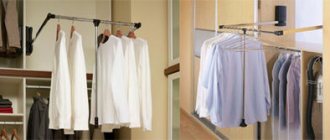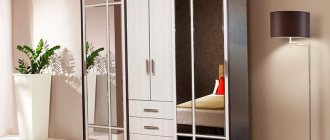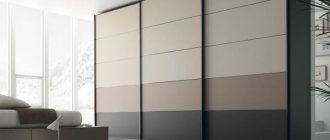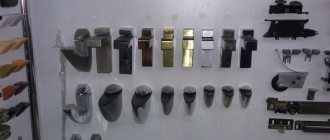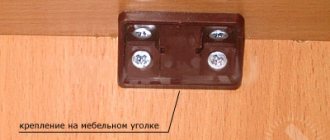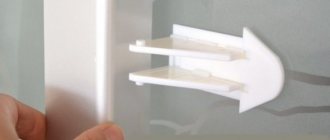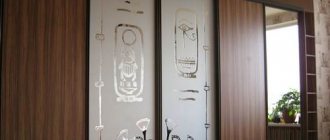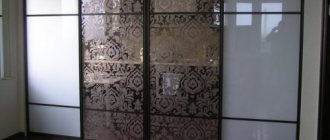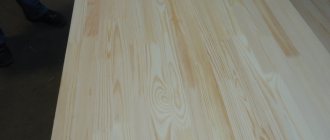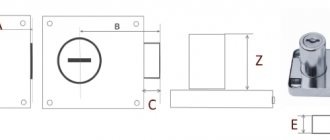Icer
5029 0 1
Icer April 27, 2018Specialization: master in the construction of plasterboard structures, finishing work and laying floor coverings. Installation of door and window units, finishing of facades, installation of electrical, plumbing and heating - I can give detailed advice on all types of work.
Today we will figure out how to make your closet more convenient to use using a device such as a pantograph. This is a special system that allows you to raise and lower the bar under the hangers at the moment you need. Thanks to this design, compartments with clothes can be located in the upper part of the closet, freeing up space below for shelves.
Pantograph is a very convenient element in modern clothing storage systems
Purpose and principle of operation
Pantographs for sliding wardrobes are a U-shaped structure made of durable metal. It is necessary as part of a sliding wardrobe to improve its performance characteristics. Thanks to the presence of a pantograph, using the cabinet becomes much more convenient. You can deliver clothes to the upper compartment of the structure autonomously and without any particular difficulties. In addition, such a product allows you to rationally zone the building according to the current season.
Manufacturers use high-strength metals in the manufacturing process of pantographs, which allows the product to withstand significant loads during operation. Therefore, even if you have quite heavy outerwear, you should not worry about the quality of the furniture; the pantograph will not break.
If we consider the structure of this cabinet element, we can note its main elements:
- sliding rod;
- control handle;
- side arms;
- boxes with slots for levers to fix the element in a certain position.
The mechanism works as follows: you can lower the bar with things by using the handle. When you press it, the moving levers will bend the plates, and they will forcefully push the structure up.
Operating principle
Purpose, design, operating principle
A pantograph is a U-shaped lever telescopic mechanism that lowers the top rod with clothes to the level of the first floor of the closet.
The lifting mechanism, consisting of two parts and equipped with a casing, is attached to the walls of the cabinet. Two side levers extend upward from it, carrying a sliding rod, to which a handle is attached in mechanical models.
As a rule, the pantograph is equipped with a rod as a support, but sometimes a cable plays this role. The retractable rod, on which hangers with clothes are hung, adjusts to the width of the closet section.
The "clothes lift" can keep expensive dresses away from pets who like to explore their surroundings and away from children who might get their clothes dirty. It is also a good solution for older people and people with disabilities.
A furniture elevator has a load limit and certain operating rules. When lowered with more clothing, the bar will move faster, sag and arch. The moment of inertia will lead to a shift in the axes and positions of the mechanism, and subsequently to premature failure.
Pros:
- comfort and easy access to the upper compartments;
- clothes are ventilated and the smell of dampness does not appear;
- there is no need to iron things, they are always smooth.
Minuses:
- noisy operating mechanism, even on new models;
- requires care and regular diagnostics;
- Over time, mechanical parts wear out;
- installation requires minimal skills in the construction industry.
Varieties
If the bedroom or children's room is not impressive in size, and the person's wardrobe is quite large, you need to think about a way to comfortably accommodate it. You can choose a small but tall wardrobe, and place clothes and accessories inside it in two tiers. And access to the second tiers is provided using a pantograph.
Today, the domestic furniture market offers sliding wardrobes with different types of pantographs inside the structure. These products differ from each other in the material of manufacture and the mechanism of functioning. We will describe the most popular categories below.
Mechanical
When choosing a sliding wardrobe for your home, it is important to think about the type of pantograph that is relevant to equip such furniture with. Such a mechanism will provide a person with access to the highest corners of the cabinet, rationally planning its internal contents. In addition, a mechanical pantograph allows you to give the clothes inside the structure a neat look and prevent them from getting wrinkled. Blouses and jackets, trousers and dresses will be aesthetically placed on hangers.
If the family budget is limited, a mechanical pantograph is quite suitable for these purposes. This is a type of pantograph in which the lifting mechanism is equipped with springs that easily return the levers to their current position.
The main operational parameters of such mechanical products are presented below.
| Characteristic | Meaning |
| Load capacity | 10-20 kg |
| Allowable boom width | 450-1250 mm |
| average cost | From 2 thousand rubles |
Electrically driven
Electrically driven clothing elevators are more convenient to use, since no effort is required to access clothes on hangers. All you have to do is press a button, which starts the motor in the wardrobe design. The crossbar with hangers is lowered, and a person can get the current outfit without additional difficulties. When there is no need to access things, pressing the button will return the pantograph to its original position. Such a mechanism is especially relevant in a children’s room, because it will be much easier for a child to use it than a mechanical version.
A more comfortable pantograph costs a lot of money, so models with an electric drive are less common than mechanical options. The average cost of a quality product starts from 7 thousand rubles. In addition, such a system must only be installed by an experienced specialist, otherwise you can make a mistake and break the mechanism.
Pantograph
Details Category:
PANTOGRAPH , a device used for redrawing plans and drawings on the same or another modified scale; invented in 1603 by Scheiner, subsequently significantly improved. It consists (Fig. 1) of four metal rods with a rectangular cross-section, connected at their ends by hinges; the rods form a parallelogram. The fastened vertices allow the parallelogram bars to change their relative position, i.e., the dimensions of the parallelogram diagonals, while remaining unchanged along their length for a given pantograph installation. The pantograph is designed in such a way that the rulers DE and BG represent the constant sides of the parallelogram, and the other two - AB and VG - are variable, for which the fastening of these rods at points D and E is arranged in such a way that it allows the rods DE and BG to be brought closer together and removed and install them in any position parallel to each other.
At points B, O and C there are cages with holes into which a bypass needle (point - B), a pencil (point - C) and a fixed vertical axis - O of rotation of the device are inserted. The clips at points B and C are stationary, but the clip at point O is rearranged along the lever DE. The rulers DE, AB and VG have millimeter divisions, which allows, during operation of the pantograph, to comply with the basic requirement for the correctness of its operation, which is that points B, O and C must lie on the same straight line. For ease of operation of the pantograph, at points B and C there are wheels on the stands that protect the paper from damage when tracing the outline of the drawing; In addition, at point G' there is a suspension on a wire, which supports the entire device suspended in a horizontal position so that the pencil and the bypass pin touch the paper. This suspension, adjustable at the very beginning of pantography work, ensures the correctness and accuracy of the device.
The principle of operation of the pantograph is based on the following 2 geometric dependencies: 1) the pencil, guide needle and axis of rotation of the device installed on one straight line remain all the time on a straight line at any position of the pantograph; 2) if the axis of rotation is motionless during work, then the figures described by the needle and pencil are similar to each other. Indeed, if points B, O and C lie on the same straight line, then due to the parallelism of DE and BG we will have (Fig. 1):
DB: TO = BE: OE (1)
At any position of the rods AB will be parallel to ВГ, the lengths of the parts of the rods DB, DO, BE and OE will remain unchanged, and therefore relation (1) will take place at any position of the pantograph. It follows that < DOB = < BOE, since the triangles DOB and BOE are similar, and therefore, if points D, O and E are located on the same line, then points B, O and C will also always lie on the same line.
To prove the 2nd condition, consider the following drawing (Fig. 2).
Let's assume that the bypass needle has moved from point B to point B'; then the pencil will move from point B to point B'. Points B, O and B, as well as B', O and B' lie on straight lines; therefore, triangles DOB and BOE, as well as triangles D'OB' and B'OE' are similar to each other; from here
BO : OV = TO : OE (2)
B'O : OV' = OD' : OE' = TO : OE (3)
If the second part of equality (2) is equal to the second part of equality (3), then, consequently, their first parts are equal. It follows that the triangles BB'O and BB'O are similar, i.e.
BB' : BB' = BO : OV = OD : OE (4)
Using equality (4) we can prove the second dependence.
The practical use of a pantograph comes down to the following: let’s say that you want to reduce a given drawing by 1/n times, for this it is necessary that
OE : OD = EB : EG = 1/n and BD = EG
The pantograph is installed according to the millimeter divisions marked on the rods, or according to special cuts marked on the rods: 1/2, 1/3,1/4, 1/5, etc. After installing the rods, the fixed axis is placed on the pantograph stand, representing a heavy load that remains motionless during the entire operation of the tool. The rods are brought into a horizontal position using an overhead level and adjustment with wires. Next, a drawing is placed under the bypass pin, and a blank sheet of paper is placed under the pencil, on which a reduced drawing is applied. After a series of comparisons in different directions regarding the correct installation of the rods or the reduction factor, redrawing begins. To ensure that when transferring from one contour to another, the pencil does not draw unnecessary lines, a special coupling is installed on the pencil in the pantograph, which can turn the pencil off from work by tensioning the string going to the bypass pin.
When operating a pantograph, the latter should be installed on a flat horizontal table, the pencil should be repaired as it becomes dull; The pressure force of the pencil is regulated by special weights placed on the pencil. Pantographs of the newest systems differ from previous ones: 1) the length of the arms, reaching up to 1 m, which makes it possible to redraw large drawings; 2) the device of a stand for installing a fixed axis, which is made more massive and screwed to the table with a clamp, which guarantees immobility and constant installation of the entire pantograph during operation; 3) more careful adjustment of the pantograph with hanging wires; 4) the perfect design of the hinges connecting the pantograph rods to each other, and 5) the design of micrometric screws for careful installation of the clips moving along the pantograph rods. (Fig. 3).
The correctness and accuracy of the pantograph operation is determined by the following conditions of its manufacture: 1) careful and precise fit of the hinge axes (no play) connecting the rods to each other; 2) careful and precise fit of the cylinder with a pencil in the coupling (no backlash); 3) precise adjustment of the socket to install the end of the fixed axis, usually ending in a sphere; 4) the correct placement of divisions on the rods, which ensures that the pencil, the bypass pin and the fixed axis are installed on the same line.
Currently, pantographs are manufactured at the factories of the Trust for Precision Mechanics in the USSR, by the Koradi company in Switzerland, by the Wichmann company in Germany, etc.
Source: Martens. Technical encyclopedia. Volume 15 - 1931
- < Back
- Forward >
Material of manufacture
Pantographs for sliding wardrobes of different sizes must certainly be durable and resistant to loads, because the wardrobe itself is purchased for more than one year, so all its internal contents must have high performance parameters.
Often, durable metals are used to manufacture modern models of pantographs: chrome, aluminum and others. This ensures the product is able to withstand significant loads, not break, and serve for as long as possible. The weight that a metal pantograph can withstand ranges from 10-20 kg. If clothes on hangers weigh more than 20 kg, then the product will simply become unusable. Therefore, when planning the space inside the wardrobe, it is important to take this fact into account.
Leather handles for furniture: modern trends in a stylish interior
The main task is to improve the performance characteristics of furniture, increase its practicality, and achieve maximum capacity. An excellent solution for those who have purchased a tall wardrobe, but at the same time cannot, due to their height or the furniture being really too tall, make full use of the space above. The pantograph makes it easy to place clothes at the top and lower them down as needed with simple movements.
Manufacturers of furniture fittings, such as GTV and the equally well-known Hafele brand, use high-strength types of metal in the manufacture of such elements.
The pantograph places increased demands on structural strength, since it is designed to withstand impressive loads during operation. You can even place winter outer clothing on it without any problems, without fear that the crossbar will break.
Moreover, for outerwear it is preferable to choose models with wall mounting, thereby guaranteeing full resistance to loads.
Rules for placement and operation
If the sliding wardrobe is selected in a furniture store or made to order, most likely the installation of the pantograph will be done by a craftsman. However, if you want to improve the functionality of an old home cabinet, you can install this mechanism yourself.
First, you will have to study the location of the shelves inside the wardrobe. If there are no niches for placing clothes on hangers, remove several shelves. If there is a niche, stock up on the latest tools:
- measuring tape, simple pencil;
- screwdriver;
- magnetic holder, bits for hardware;
- drill 3 mm;
- hex wrench.
Once the list of tools has been prepared, begin installing the mechanism. To determine the current location of the crossbar, consider what clothes will hang on it. If dresses, coats, the crossbar are mounted at a level of 1-1.2 m from the bottom shelf. If only jackets and blouses are at the level of 0.8 m.
It is extremely important to determine the lower level of the product, for which you will need to measure its height (from the bottom of the box with the lifting mechanism) and add another 30 mm to this value.
In order for the installation to be more reliable, of high quality, and for the structure to withstand maximum weight, it is important to drill the racks for self-tapping screws. When fixing mounting strips and levers to the side wall of the cabinet and installing a rod with a handle, it is important to accurately match the holes in the strips with the previously prepared blind holes in the partitions. It is important not to confuse the right-hand and left-hand levers, and also not to overdo it with pressure when screwing in the screws. Otherwise, the work will have to be repeated from the beginning.
As for the operating rules, they are simple. It is important not to overload the structure, specifying the maximum permissible weight of clothing in the instructions.
How to install a pantograph for clothes with your own hands and avoid making mistakes
Directly attaching a pantograph for clothes to a closet is extremely simple and straightforward; just follow the recommendations in the instructions.
It is important to maintain alignment and clear symmetry when attaching the base to the sides. The slightest misalignment negatively affects both the service life of the mechanism and the comfort of operation.
According to the instructions, first measure the fastening of the side mechanisms at the expected level of lowering of the clothing pantograph. Most often they are attached using 3x16 self-tapping screws, which are included in the kit.
Then the side posts of the mechanism are lowered and a horizontal crossbar, already assembled with a handle, is screwed to them, which will serve as a bar for clothes.
At first, the movement of a pantograph without hangers will be “tight”, with the need to make efforts to lower it. But over time, under the weight of the clothing, it will develop and become smooth and comfortable.
How to choose
When choosing a pantograph for a wardrobe, it is important to be guided by the following criteria:
- price and management principle. Mechanical models are slightly cheaper than electric ones. And excessively cheap products should scare away the buyer in both cases. Most likely, a cheap product will very quickly lose functionality;
- quality - the selected product must certainly be made of high-quality materials, otherwise it will last a short time. Ask the seller if there is a quality certificate. Products without such a document included are not worth the attention of buyers;
- dimensions - carefully measure your wardrobe using a construction tape. This will allow you to determine the current dimensions of the pantograph.
If you have minimal experience in such matters, you can seek help from an experienced specialist. He can also install the product.
Advantages and disadvantages
In most cases, a pantograph helps improve the quality of life. But it also has disadvantages.
- makes it easier to find, get and hang things in the closet;
- improves ventilation: clothes are fresher;
- makes it easier for older people and people with disabilities to get things;
- frees up the lower part of the cabinet for additional shelves;
- reduces the need for ironing: you can hang more clothes than in a regular closet.
The main disadvantage is wear and tear over time. Gradually, backlashes form between the structural parts, which disables the entire mechanism.
It is almost impossible to repair individual parts of the pantograph; the entire system has to be replaced.
This design is inferior to a conventional horizontal hanger bar, which can last forever
Another drawback is the possible creaking of parts during operation. This becomes a problem if the closet is located in a shared bedroom. Compared to a regular bar, pantographs are significantly more expensive and require more complex installation.
Corner sofas with pantograph mechanism
A corner sofa will fit perfectly into both small and spacious rooms, which makes it one of the most popular types of upholstered furniture. Compared to the classic straight one, the corner version is easily placed in the corners of the room, leaning against the wall. It has more capacity to store even more items and a surface area that can accommodate multiple people at once to celebrate or watch a sports game.
Video of the pantograph mechanism for a sofa. The video clearly shows the simplicity and ease of handling the mechanism, as well as the speed with which a piece of furniture is transformed into a spacious sleeping area.
Characteristics and distinctive features
The “pantograph” design is easy to operate, having a pendulum mechanism based on the principle of transformation, which occurs in two stages. The use of spring blocks and rods ensures synchronization of movement, and the absence of auxiliary parts significantly increases the strength and reliability of the piece of furniture, while reducing its cost.
In order to unfold a sofa with a pantograph mechanism, you only need to pull the loop securely sewn to the seat, causing it to rise upward. After this, the seat easily moves forward, holding on to the lower part, and then the backrest lowers.
Important! The difference from other similar devices is the absence of roll-out rollers when unfolding, which, with frequent use, can damage the floor covering.
The cost of sofas with this mechanism directly depends on the country of origin of the components and transformation options, which are:
- Manual. The most affordable option, due to the fact that there is a need to manually remove the pillows from the back and then transfer them to the empty part of the sofa.
- Automatic. A rather expensive solution, but it does not require any effort due to the fact that after the seat is pulled out, the cushions automatically fall into the free space.
Advantages and disadvantages of such a scheme
Transforming sofas with a pantograph mechanism have an attractive price, beautiful modern design and a large number of technical advantages. Their most significant advantages include:
- Simplicity of design ensuring reliability in use.
- No damage to the flooring or wrinkled carpets.
- Easy transformation, rare breakdowns, no squeaks.
- A spacious drawer for storing bed linen and other attributes.
- Attractive appearance, compact dimensions when folded.
- The ability to install the sofa close to the wall, while saving space in the room.
- An absolutely flat surface that guarantees comfort while sleeping.
An additional advantage of the pantograph mechanism is that it does not have any disadvantages. There is only one point that is often paid attention to - the higher cost compared to sofas equipped with roll-out casters. This is a rather ambiguous opinion, because the huge list of positive qualities of furniture that has this mechanism allows you to not pay absolutely no attention to price comparisons, especially considering that the difference in cost is not so great.
Wardrobe arrangement inside
Buying ready-made furniture is much easier than planning the internal structure of the wardrobe that you need. If you take your needs into account correctly, your future cabinet will be more pleasant and convenient to use.
The minimum set of elements for the internal structure of a wardrobe includes shelves, rods, drawers and metal baskets. Let's look at each of them in more detail.
Shelves
The structure of the wardrobe inside is based precisely on the shelves that zone its space. Items placed on the shelves are easy to reach. No less convenient are the mezzanine shelves located along its entire length, designed for storing rarely needed items. There are also pull-out shelves, which are especially useful if the closet is very deep. By pulling out such a shelf, it is easy to find the necessary thing.
Boxes
They are convenient for storing small items. The number of drawers is determined by the customer, and there may be cases when the height and number of drawers can be changed during the operation of the cabinet.
Barbells
Pantographs and rods are intended for outerwear. They are made of chrome-plated steel, they can withstand significant loads. If the height of the cabinet allows, then a pantograph for things can be arranged on the second floor, which helps to use the space more efficiently.
If the depth of the cabinet is small, then you can increase its capacity using a cross hanger. Clothes placed transversely in it will make more efficient use of space.
Baskets
It is very convenient to store things in them, since they are well ventilated. In addition, it is easier to find the item you need, since it can be seen through the bars. This is an ideal place for socks, underwear, sweaters or children's toys.
Additional items
The internal designs of sliding wardrobes are often complemented by other elements:
Trouser
For supporters of strict clothing, it is important that trousers are taken out of the closet every day without being wrinkled, which is why the trouser rack was invented. Tiemaker
Tiemaker
With the help of a tie maker, you can quickly find a suitable tie among all the models placed on it. Some manufacturers have it equipped with a backlight so that, without leaving the closet, it is easy to figure out how harmonious a suit is with a particular tie.
Belt hanger
A separate hanger may also be provided for belts, but if it is not there, then they can be stored rolled into rolls.
There is also room in the closet for other items; for example, thanks to a special fastening, the vacuum cleaner hose will not get in the way.
